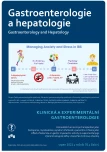Pelvic floor disorders of women from the point of coloproctologist‘s view
Authors:
Berková A. 1; Vlček P. 1; Červeňák V. 2; Dolina J. 3; Vystrčilová T. 1; Hemmelová B. 1; Chovanec Z. 1
Authors place of work:
I. chirurgická klinika LF MU a FN u sv. Anny v Brně
1; Klinika zobrazovacích metod LF MU a FN u sv. Anny v Brně
2; Interní gastroenterologická klinika LF MU a FN Brno
3
Published in the journal:
Gastroent Hepatol 2022; 76(4): 319-326
Category:
Klinická a experimentální gastroenterologie: přehledová práce
doi:
https://doi.org/10.48095/ccgh2022319
Summary
Disorders of the pelvic floor and anorectal dysfunction are a major cause of discomfort for many women. As a result of shyness and embarrassment, women come for medical examination after a longer period of difficulties, mostly for progressive disorder of defecation and continence. Despite the low morbidity, anorectal dysfunctions have a very significant impact on patient’s quality of life and therefore diagnosis and subsequent treatment should be aimed at every possible cause. Gastroenterological examination can play an important part In primary detection, but also in the multidisciplinary diagnostic process of pelvic floor pathology. Likewise, coloproctology is an integral part of the diagnostic-therapeutic algorithm of pelvic dysfunctions. The aim of the article is to provide information on the pathophysiology, diagnosis and treatment of anorectal disorders from the perspective of coloproctology. Anorectal dysfunctions are a multidisciplinary problem, therefore, to achieve good treatment results, the cooperation of different specializations is essential.
Keywords:
Incontinence – Defecation – prolapse – anorectal dysfunction – rectocele – rectopexy
Zdroje
1. Chapman GC, Sheyn D, Slopnick EA et al. Perioperative Safety of Surgery for Pelvic Organ Prolapse in Elderly and Frail Patients. Obstet Gynecol 2020; 135 (3): 599–608. doi: 10.1097/AOG.0000000000003682.
2. Rogers, RG, Fashokun, TB. Pelvic organ prolapse in females: Epidemiology, risk factors, clinical manifestations, and management. 2022 [online]. Available from: https: //www.uptodate.com/contents/pelvic-organ-prolapse-in-females-epidemiology-risk-factors-clinical-manifestations-and-management.
3. Barber MD, Maher C. Epidemiology and outcome assessment of pelvic organ prolapse. Int Urogynecol J 2013; 24: 1783–1790. doi: 10.1007/s00192-013-2169-9.
4. Kim JK, Kim YJ, Choo MS et al. The urethra and its supporting structures in women with stress urinary incontinence: MR imaging using an endovaginal coil. AJR Am J Roentgenol 2003; 180 (4): 1037–1044.
5. Horák L, Skřička T, Šlauf P et al. Praktická proktologie. Praha: Grada 2013.
6. Patcharatrakul T, Rao SSC. Update on the Pathophysiology and Management of Anorectal Disorders. Gut Liver 2018; 12 (4): 375–384. doi: 10.5009/gnl17172.
7. Raizada V, Bhargava V, Karsten A et al. Functional morphology of anal sphincter complex unveiled by high definition anal manometery and three dimensional ultrasound imaging. Neurogastroenterol Motil 2011; 23 (11): 1013–1019. doi: 10.1111/j.1365-2982.2011.01782.x.
8. DeLancey JO. The anatomy of the pelvic floor. Curr Opin Obstet Gynecol 1994; 6 (4): 313–316.
9. Attaallah W. Update on the pathophysiology of rectal prolapse. Turk J Gastroenterol 2019; 30 (12): 1074–1075. doi: 10.5152/tjg.2019.19 196.
10. Rockwood TH, Church JM, Fleshman JW et al. Patient and surgeon ranking of the severity of symptoms associated with fecal incontinence: the fecal incontinence severity index. Dis Colon Rectum 1999; 42 (12): 1525–1532. doi: 10.1007/BF02236199.
11. Moalli PA, Ivy AJ, Meyn LA et al. Risk factors associated with pelvic floor disorders in women undergoing surgical repair. Obstet Gynecol 2003; 101 (5): 869–874. doi: 10.1016/s0029- 7844 (03) 00078-4.
12. Ortega AE, Cologne KG, Lee SW. Management of Rectal Prolapse – The State of the Art. JSM Gen Surg Cases Image 2017; 2 (1): 1018.
13. Maccioni F. Functional disorders of the ano-rectal compartment of the pelvic floor: clinical and diagnostic value of dynamic MRI. Abdom Imaging 2013; 38 (5): 930–951. doi: 10.1007/s00261-012-9955-6.
14. Bertschinger KM, Hetzer FH, Roos JE et al. Dynamic MR imaging of the pelvic floor performed with patient sitting in an open-magnet unit versus with patient supine in a closed-magnet unit. Radiology 2002; 223 (2): 501–508. doi: 10.1148/radiol.2232010665.
15. Roos JE, Weishaupt D, Wildermuth S et al. Experience of 4 years with open MR defecography: pictorial review of anorectal anatomy and disease. Radiographics 2002; 22 (4): 817–832. doi: 10.1148/radiographics.22.4.g02jl02817.
16. Sákra L, Šiller J. ODS – Obstrukční defekační syndrom – souhrnné sdělení. Rozhl Chir 2017; 96 (6): 247–251.
17. Martínek J. Zácpa – častý problém. Prakt Lékáren 2010; 6 (1): 15–21.
18. Pescatori M, Boffi F, Russo A et al. Complications and recurrence after excision of rectal internal mucosal prolapse for obstructed defaecation. Int J Colorectal Dis 2006; 21 (2): 160–165. doi: 10.1007/s00384-005-0758-x.
19. Örhalmi J. Proktologie vyššího věku – prolaps rekta. Postgraduální gastroenterologie & hepatologie 2016; 2 (4): 150–153.
20. Ihnát P, Jelínek P, Guňková P et al. Chirurgická léčba rektokély – mnoho technik, málo jednoznačných závěrů. Rozhl Chir 2014; 93 (4): 188–193.
21. De Wachter S, Knowles CH, Elterman DS et al. New Technologies and Applications in Sacral Neuromodulation: An Update. Adv Ther 2020; 37 (2): 637–643. doi: 10.1007/s12325- 019-01205-z.
22. Jelovsek JE, Gantz MG, Lukacz E et al. Success and failure are dynamic, recurrent event states after surgical treatment for pelvic organ prolapse. Am J Obstet Gynecol 2021; 224 (4): 362.e1–362.e11. doi: 10.1016/j.ajog.2020.10.009.
23. Dunivan GC, Sussman AL, Jelovsek JE et al. Gaining the patient perspective on pelvic floor disorders‘ surgical adverse events. Am J Obstet Gynecol 2019; 220 (2): 185.e1–185.e10. doi: 10.1016/j.ajog.2018.10.033.
Štítky
Dětská gastroenterologie Gastroenterologie a hepatologie Chirurgie všeobecnáČlánek vyšel v časopise
Gastroenterologie a hepatologie

2022 Číslo 4
- Metamizol jako analgetikum první volby: kdy, pro koho, jak a proč?
- MUDr. Lenka Klimešová: Multioborová vizita může být klíčem k efektivnější perioperační léčbě chronické bolesti
- Horní limit denní dávky vitaminu D: Jaké množství je ještě bezpečné?
- Realita léčby bolesti v paliativní péči v Německu
Nejčtenější v tomto čísle
- Poruchy pánevního dna u žen z pohledu koloproktologa
- Význam biologické léčby v časné fázi Crohnovy choroby: mini-review
- Odešel MUDr. Ivo Novotný, CSc., a endoskopické Brno už nebude nikdy stejné
- Sarkopenie, myosteatóza a syndrom křehkosti u pacientů s cirhózou jater
